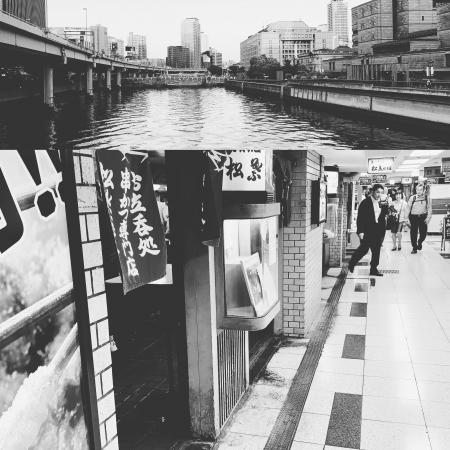建築と訛り
短時間で、勝手にイメージしている、コテコテの大阪に触れたくて、梅田の食堂街の中にある、老舗の串揚げ屋、そこは立ち飲み、でサクッと、昼間だし、軽くと思いつつ、10本以上に2杯、いい感じ、コレコレと思いつつ。
大阪駅周辺、日本中のどこの大都市も一緒だけれど、建築だけを見ていたら、案外どこがどこだかわからない。
行き交う人々も、ユ○○ロのおかげか、いい意味で、服装も地域によって変わりなく、海外の方は服の色合いの好みが違うからわかるが、それは日本の中だったら、どこでもあまり変わらない。
飛び交う言葉、方言、訛りだけが、音として耳に残り、「ああ、ここは」と思い出すが、それも、それ程でも無く、標準語しか聞かないことが多いような、そう、だから、串揚げ屋でも、雰囲気はイメージしている大阪、でも何か足りないな、と後で思い、そういえば、大阪弁を聞いていない、お客はもしかしたら、大阪の方で無い人も多いのかもしれないけれど、お店の人も結構標準語だったし。それは、大きく雰囲気を損なうかな、お店のつくりは真似ができるから、今、東京でも、大阪の串揚げ屋がたくさんあるし。ただ、ちょっとだけ言葉尻に大阪弁が出るような気がして、ああ大阪、の雰囲気はあった。
建築を言葉で表現する時もある。だから、訛りのような地域の違いが、建築にもある。例えば、合掌造りのような建築は、その地方の気候風土、生活様式を反映している、訛りもその地方の気候風土、生活様式を反映している。
だから、日本中のどこの大都市も建築だけを見ていたら、どこがどこだかわからなくなっている、標準語しか聞かない、は同じようなことなのか、どちらが先かはわからないけれど。
"Architecture and resentment"
In a short time, I want to touch the image of Kotekote Osaka, which I imagined for myself, and in the cafeteria town of Umeda, there is a long-established salmon fried restaurant, there is a standing drink, it is quick, it is daytime, I think lightly , 2 cups over 10, feeling good, while thinking that it is korekore.
Around Osaka Station and any major city in Japan are the same, but if you look only at the architecture, you can not know where to go.
People come and go, thanks to Yu ○ ○ R, in a good sense, clothes are the same in different regions, foreign people are different from the preference of the color of clothes is different, but it is not much change anywhere in Japan.
Only words that fly around, dialects and indignations remain in the ear as sounds, and I remember "Oh, here", but it's not that much, and often I only listen to standard words, yes, so, so, 串However, I think that the atmosphere is Osaka, but I think that something is missing later, speaking of it, I have not heard the Osaka dialect, but the customers may be that there are many who are not Osaka , People in the shop were also quite standard language. It's a big loss of atmosphere, and you can imitate the making of shops, so now there are a lot of fried salmon shops in Osaka, also in Tokyo. However, I felt like I could have an Osaka dialect in the bottom of the words, there was an atmosphere of Osaka, oh.
There are also times when words are used to express architecture. So, there is a difference in the area like resentment, also in architecture. For example, an architecture such as "Gashi" is reflecting the climate and lifestyle of the region, and the reflection also reflects the climate and lifestyle of the region.
So if you're looking at architecture in any big city in Japan, you don't know where it's gone, you're just asking the standard language, or something like that, but you don't know which one goes first.

